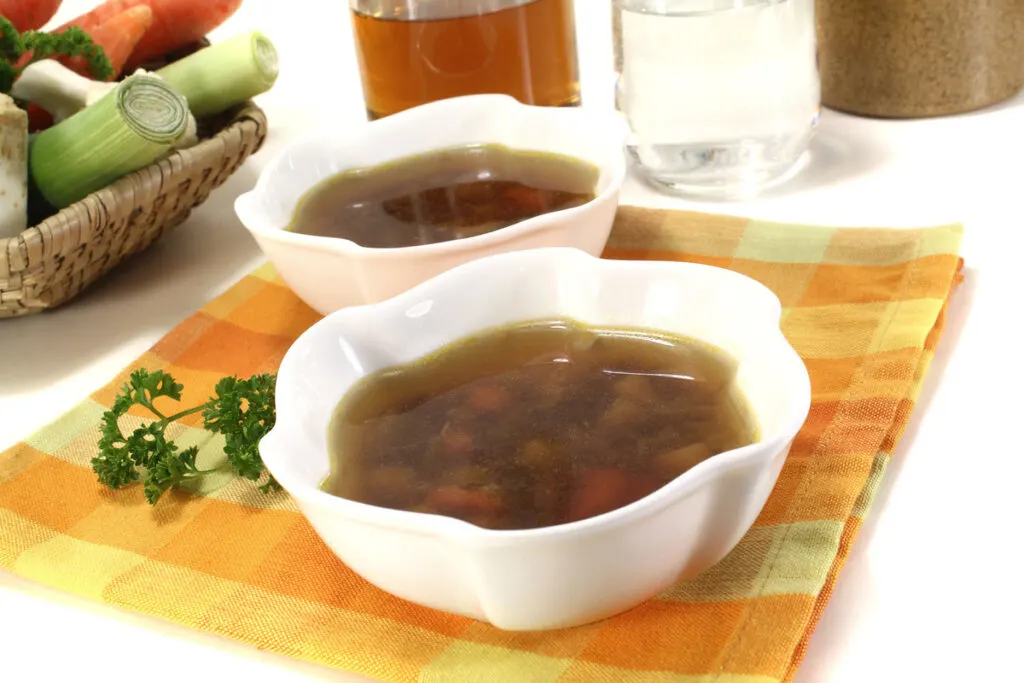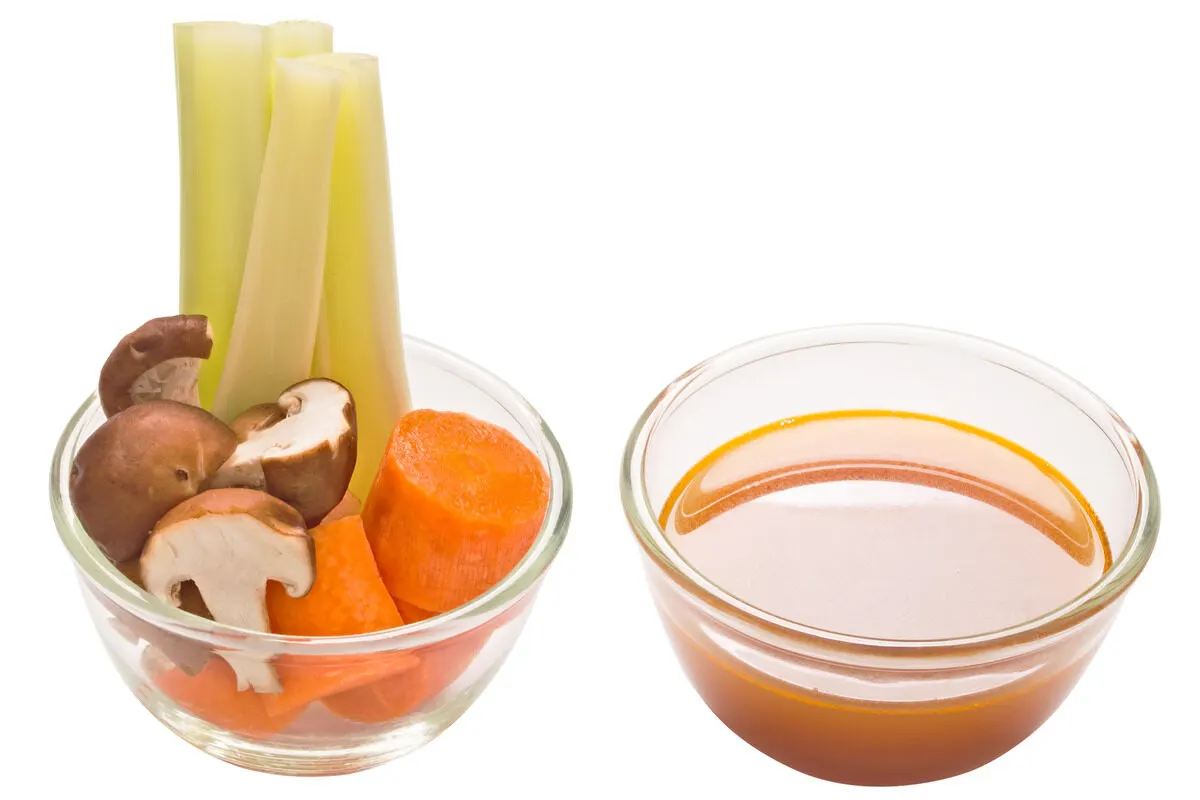Au jus is a fantastic and delicious little sauce splashed onto meat recipes and various sauces for pork chops meats. But like many other sauces, they’re available or practical to make. Fortunately, I have several of the best au jus substitutes with a similar, if not better, flavor. You can substitute au jus with beef stock powder sauce, beef broth substitutes, beef consommé swaps, and beef cubes. But this isn’t all, so let’s hop into every au jus swap you can use!

Jump To
🤷 What is Au Jus?
Au Jus is a thin, flavorful sauce made from the natural juices of meat that have been cooked. It’s often made using a pre-packaged au jus gravy mix, which contains a combination of beef broth, seasonings, and other ingredients. However, it can be made at home using natural juices from meat, beef broth, and seasonings. The sauce is typically served alongside meat like prime rib, roast beef, and other beef dishes.
🧑🍳 How to Make Au Jus
To make Au Jus, we need beef broth and some seasonings. Here’s how we can make it:
- Heat a saucepan over medium heat.
- Pour in the beef broth and bring it to a boil.
- Reduce the heat and let it simmer for 5-10 minutes.
- Add the seasonings of your choice. These can be garlic, onion powder, thyme, and black pepper.
- Let the mixture simmer for another 5-10 minutes.
- Strain the mixture through a fine-mesh sieve to remove any solid particles.
- Serve the Au Jus hot with your favorite dish.
📌 How to Use Au Jus
- French Dip Sandwich:
- Dip sliced roast beef or steak into au jus before assembling the sandwich. Serve the sandwich with a side of au jus for dipping.
- Beef Au Jus Pasta:
- Toss cooked pasta with shredded beef and au jus for a flavorful pasta dish.
- French Onion Soup:
- Use au jus as the base for the soup instead of beef broth.
- Beef and Mushroom Stir-Fry:
- Stir-fry sliced beef with mushrooms and onions. Add au jus towards the end of cooking to create a rich sauce.
- Au Jus Braised Short Ribs:
- Braise short ribs in a mixture of au jus and red wine until tender. You can also make pork chop sauces out of it.
- Philly Cheesesteak with Au Jus:
- Use au jus as a dipping sauce for a classic Philly cheesesteak sandwich filled with thinly sliced beef, sautéed onions, and melted cheese.

💡 Best Au Jus Substitutes
Beef Stock Powder Sauce
1 cup of au jus = 1 cup of mixed beef stock powder sauce
Beef stock powder sauce is a concentrated and flavorful beef-flavored sauce that can be diluted with water to make a flavorful broth. This sauce is also a great alternative to au jus because it has a similar flavor and consistency. It’s especially great in French dip sandwiches and beef stews. To use this sauce, mix 1 tablespoon of beef stock powder with 1 cup of water and adjust the amount of beef stock powder to your liking.
Beef Bouillon Cubes
1 cup of au jus = 1 cup of mixed beef bouillon cubes
Beef bouillon cubes are a convenient swap for au jus made from dehydrated beef stock, salt, and other seasonings. These small cubes are relatively inexpensive and available in most grocery stores. They may not provide the same depth of flavor as a homemade au jus or other alternatives, so keep this in mind when picking convenience over taste. Simply dissolve one or two cubes in hot water and add to your recipe for an easy and quick flavor boost.

Beef Broth
1 cup of au jus = 1 cup of beef broth
Homemade beef broth is a direct and flavorful replacement for au jus made by simmering beef bones, vegetables, and herbs for several hours. Store-bought beef broth is the best convenient option, as they’re available in most stores. However, look for high-quality options with minimal additives and low sodium content, as some tend to be quite high in sodium.
Beef Consommé
1 cup of au jus = 1/2 cup of beef consommé
Beef consommé is a perfect alternative to au jus. It’s a clear and flavorful soup made from beef broth that has been clarified to remove impurities. It’s a popular ingredient in French cuisine and can be used in tons of recipes, adding depth and richness to stews, soups, and sauces. This highly available ingredient can even be used straight from the can or diluted with water to achieve a better consistency.
| Au Jus | Beef Consommé |
| Made from the drippings of roasted meat | Made from beef broth, vegetables, and seasonings |
| Has a thin consistency | Has a thicker consistency |
| Often used as a dipping sauce for beef dishes | Used as a base for soups, stews, and gravies |
| Contains more sodium than beef consommé | Contains less sodium than au jus |
| It can be more expensive to make at home | It can be easily found in stores |

Brown Gravy or Mix
1 cup of au jus = 1/4 to 1/2 serving of mixed brown gravy
Brown gravy or mix is one of the most convenient and cost-friendly alternatives for au jus in heavy recipes. This gravy is made from beef broth, flour, and seasonings, such as salt, pepper, and onion powder, with a rich, deep flavor. Brown gravy or mix can be saltier than au just, so you’ll have to dilute it for a more even taste. You can even use browning sauce substitutes for a taste similar to au jus.
Vegetable Stock
1 cup of au jus = 1 cup of vegetable stock
For those who prefer a healthier and delicious meat-free alternative to au jus, vegetable stock is just what you need. Made by simmering vegetables, herbs, and spices in water for several hours, it can be strained and used as a base for soups, stews, and sauces. Not only is it low in fat and calories, but it also packs a load of health benefits and abilities, thanks to the combination of various veggies, that can make any meal a nutritious powerhouse.

Chicken Broth
1 cup of au jus = 1 cup of chicken broth
Chicken broth is a fantastic and highly sort after broth thanks to its high usability in dishes. It can be used in sauces, gravies, marinades, and used to cook rice, quinoa, and other grains. It’s made by simmering chicken bones, vegetables, and herbs in water for several hours. Homemade chicken broth is also a superb option for those who want to control the ingredients in their food. Store-bought options are also highly available. Just look for high-quality chicken broth with minimal additives.
🧐 FAQs
Au jus sauce is made from the juices of cooked meat, typically beef. The juices are typically mixed with beef broth and seasoned with herbs and spices such as thyme, garlic, and bay leaves.
Au jus gravy mix is a powdered mixture of beef broth, cornstarch, and seasonings that can be used to make a quick and easy version of au jus sauce.
Au jus typically has a savory, rich flavor with hints of beefiness and a slightly salty profile.
